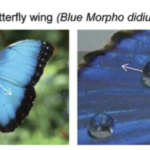Particle Adhesion Measurements on Insect Wing Membranes Using Atomic Force Microscopy
Many insects have evolved refined self-cleaning membrane structuring to contend with an environment that presents a range of potential contaminates. Contamination has the potential to reduce or interfere with the primary functioning of the wing membrane or affect other wing cuticle properties, (for example, antireflection). Insects will typically encounter a variety of airborne contaminants which include plant matter and soil fragments. Insects with relatively long or large wings may be especially susceptible to fouling due to the high-wing surface area and reduced ability to clean their extremities.
Learn about our two Decals!
 Click here to find out more about our Fall Bioinspired Design Decal and our Spring Bioinspired Design in Action Decal – ALL MAJORS are welcome.
Click here to find out more about our Fall Bioinspired Design Decal and our Spring Bioinspired Design in Action Decal – ALL MAJORS are welcome.Berkeley BioDesign Community
 Click here to learn about the BioD: Bio-Inspired Design @ Berkeley student organization or here to signup for more info.
Click here to learn about the BioD: Bio-Inspired Design @ Berkeley student organization or here to signup for more info.Search
Student Login




I imagine that the neurological circuits underlying these processes are governed by both 2d spacing maps with their brains as…
to reduce the impact of car accidents, it may be possible to study the force diverting physics of cockroaches to…
you see this type of head-bobbing stability in many avian creatures related to pigeons like chickens. the head ability to…
not like they taught horses how to run! this is an example of convergent evolution where both sea creatures and…
The brain functions in a similar way with neuronal connections. our brains are able to utilize the multiplicity of connections…